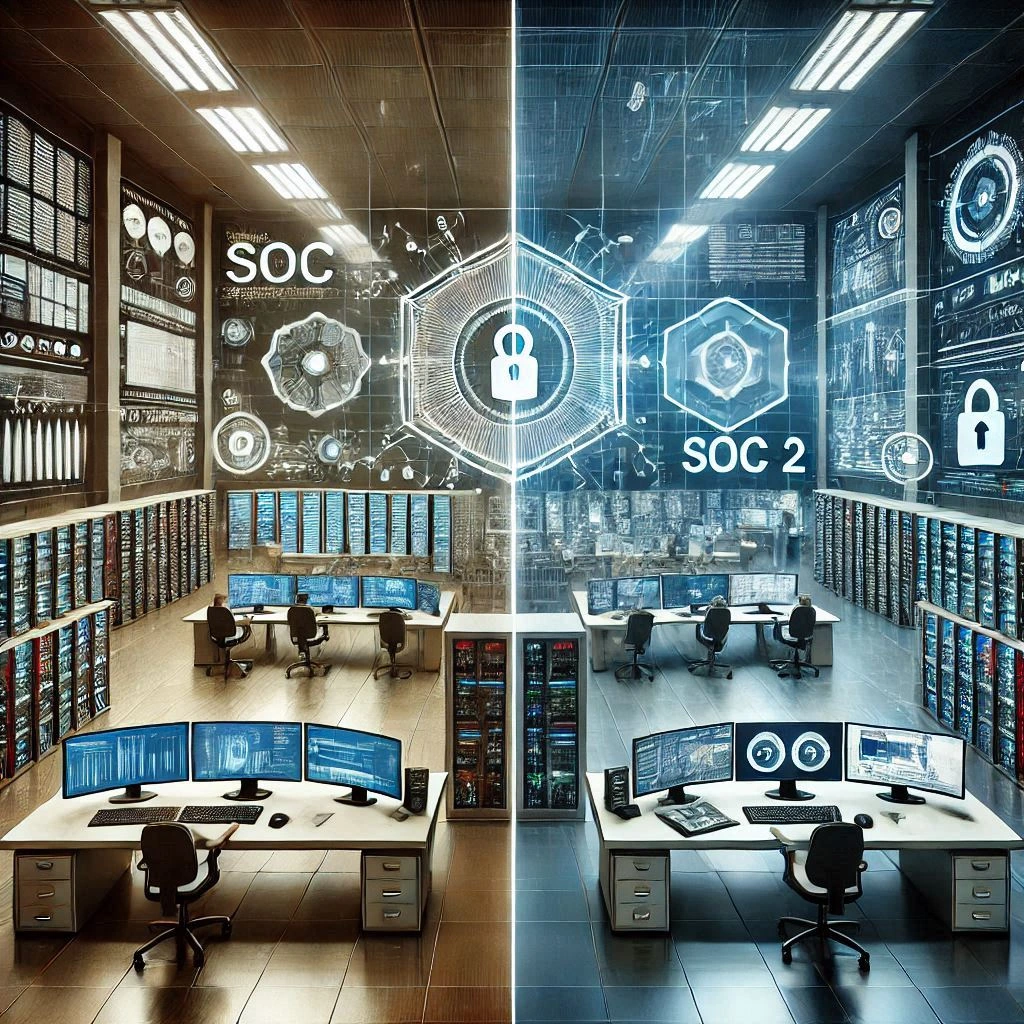Introduction
Organizations are increasingly turning to structured frameworks to bolster their cybersecurity measures and ensure compliance with industry standards. One such framework is the System and Organization Controls (SOC), which encompasses various assessments designed to evaluate the effectiveness of an organization’s internal controls. SOC reports play a crucial role in providing stakeholders with assurance regarding the management of risks, particularly in the context of cybersecurity.
Two prominent frameworks within the SOC umbrella are SOC for Cybersecurity and SOC 2. While both frameworks aim to enhance an organization’s risk management capabilities, they cater to different needs and audiences. SOC for Cybersecurity focuses on an organization’s overall cybersecurity risk management program, assessing policies, procedures, and controls related to cybersecurity. In contrast, SOC 2 is tailored for service organizations, emphasizing controls relevant to the Trust Services Criteria, such as security, availability, and confidentiality.
This blog post aims to evaluate the effectiveness of SOC for Cybersecurity and SOC 2 in mitigating risks. By examining their distinct purposes, audiences, and scopes, we will provide insights that can help Risk Management Officers make informed decisions about which framework best aligns with their organization’s risk management objectives. Understanding these differences is essential for organizations seeking to enhance their cybersecurity posture and effectively manage potential risks in an increasingly complex digital landscape.
Understanding SOC for Cybersecurity
SOC for Cybersecurity is a framework designed to help organizations assess and communicate their cybersecurity risk management efforts. Developed by the American Institute of Certified Public Accountants (AICPA), this framework provides a structured approach to evaluating an organization’s cybersecurity posture and the effectiveness of its risk management strategies.
Key Aspects of SOC for Cybersecurity
- Focus on Cybersecurity Risk Management: Unlike other SOC reports, SOC for Cybersecurity specifically concentrates on an organization’s overarching cybersecurity risk management program. It aims to identify, analyze, evaluate, and address cybersecurity threats, making it a vital tool for organizations looking to enhance their security measures and resilience against cyber incidents [2][7].
- Criteria Addressed: The SOC for Cybersecurity framework encompasses a comprehensive examination of an organization’s information risk management program. It evaluates the systems, processes, and controls in place to detect, prevent, and respond to cybersecurity breaches. This includes assessing the effectiveness of security measures and the organization’s ability to manage risks associated with sensitive data [12][14].
- Audience and Stakeholders: The reports generated under the SOC for Cybersecurity framework are beneficial for a wide range of stakeholders. This includes risk management officers, executive management, and board members who require insights into the organization’s cybersecurity posture. Additionally, clients and partners can gain confidence in the organization’s commitment to cybersecurity, as the reports provide transparency regarding the measures taken to protect sensitive information [14][15].
Understanding SOC 2
SOC 2, or System and Organization Controls 2, is a framework designed to evaluate the controls at a service organization relevant to five core principles known as the Trust Services Criteria: Security, Availability, Processing Integrity, Confidentiality, and Privacy. This framework is particularly significant for organizations that handle sensitive data, as it provides a structured approach to assessing and managing risks associated with data protection and privacy.
Definition and Core Principles
- Definition: SOC 2 is a report that focuses on the internal controls of a service organization, specifically those that impact the security and privacy of customer data. It is part of the broader SOC reporting framework overseen by the American Institute of Certified Public Accountants (AICPA) and is essential for organizations that provide services to clients, particularly in the technology sector.
- Core Principles: The Trust Services Criteria underpinning SOC 2 include:
- Security: Protection of the system against unauthorized access.
- Availability: Accessibility of the system as stipulated by service level agreements.
- Processing Integrity: Assurance that system processing is complete, valid, accurate, timely, and authorized.
- Confidentiality: Protection of information designated as confidential.
- Privacy: Management of personal information in accordance with privacy policies and regulations.
These principles serve as a foundation for evaluating the effectiveness of an organization’s controls and risk management strategies.
Applicability to Service Organizations and Technology Companies
SOC 2 is particularly applicable to service organizations, especially those in the technology sector, such as cloud service providers, SaaS companies, and data hosting services. These organizations often handle vast amounts of sensitive customer data, making it crucial to have robust controls in place to mitigate risks associated with data breaches and privacy violations. By adhering to SOC 2 standards, these companies can demonstrate their commitment to maintaining high levels of data security and privacy, which is increasingly important in today’s digital landscape.
Evaluating Controls Related to Data Protection and Privacy
SOC 2 reports play a vital role in evaluating the effectiveness of an organization’s controls related to data protection and privacy. These reports provide an independent auditor’s assessment of the organization’s adherence to the Trust Services Criteria, offering insights into the design and operational effectiveness of its controls. Key benefits of SOC 2 reports include:
- Transparency: They provide stakeholders with a clear understanding of the organization’s risk management practices and controls.
- Trust: By obtaining a SOC 2 report, organizations can build trust with clients and partners, demonstrating their commitment to safeguarding sensitive information.
- Continuous Improvement: The audit process encourages organizations to regularly assess and improve their controls, fostering a culture of risk management and compliance.
Comparative Analysis: SOC for Cybersecurity vs SOC 2
Understanding the distinctions between SOC for Cybersecurity and SOC 2 is crucial for Risk Management Officers. Both frameworks serve to enhance an organization’s risk management strategies, but they do so through different lenses and methodologies. Below is a detailed evaluation of their focus areas, assessment methodologies, and intended outcomes.
Focus Areas
- SOC for Cybersecurity: This framework is primarily concerned with an organization’s overall cybersecurity risk management program. It assesses the effectiveness of policies, procedures, and controls related to cybersecurity, providing a comprehensive view of how well an organization manages its cyber risks. The SOC for Cybersecurity is designed to be flexible and can be adapted to various entities, making it suitable for a wide range of organizations [5][10].
- SOC 2: In contrast, SOC 2 focuses specifically on data security and privacy, evaluating controls relevant to the Trust Services Criteria (TSC). This framework is particularly relevant for service organizations, such as SaaS providers, that handle customer data. SOC 2 reports are structured around five principles: security, availability, processing integrity, confidentiality, and privacy, which guide organizations in managing customer data effectively [8][15].
Assessment Methodologies and Reporting Frameworks
- SOC for Cybersecurity Assessment: The examination under this framework provides an independent, entity-wide assessment of cybersecurity risk management efforts. It encompasses a broad range of cybersecurity practices and is designed to give stakeholders, including boards and investors, a clear understanding of the organization’s cybersecurity posture [2][3].
- SOC 2 Assessment: The SOC 2 audit evaluates the design and operational effectiveness of controls over a specified period, typically focusing on the implementation of security measures and their effectiveness in protecting data. There are two types of SOC 2 reports: Type 1, which assesses the design of controls at a specific point in time, and Type 2, which evaluates the operational effectiveness of those controls over a defined period [13][14].
Intended Outcomes and Risk Management Addressal
- Outcomes of SOC for Cybersecurity: The primary goal of SOC for Cybersecurity is to provide a comprehensive assessment that helps organizations identify and mitigate cybersecurity risks. By focusing on the entire cybersecurity risk management program, it aims to enhance the organization’s resilience against cyber threats and improve stakeholder confidence in its risk management capabilities [5][10].
- Outcomes of SOC 2: SOC 2 reports are intended to assure clients and stakeholders that an organization has implemented effective controls to protect sensitive data. The focus on data security and privacy helps organizations demonstrate compliance with industry standards and build trust with customers, which is essential for maintaining business relationships [8][11].
Effectiveness in Risk Mitigation
Both frameworks serve unique purposes and can be effective in different scenarios, contributing to an organization’s overall risk mitigation strategies.
SOC for Cybersecurity: Scenarios for Enhanced Benefit
- Comprehensive Cybersecurity Risk Management: The SOC for Cybersecurity framework is designed to assess an organization’s entire cybersecurity risk management program. It evaluates policies, procedures, and controls specifically related to cybersecurity, making it particularly beneficial for organizations looking to enhance their overall cybersecurity posture. This framework is ideal for organizations that need to communicate their cybersecurity efforts to stakeholders and demonstrate a commitment to managing cyber risks effectively [1][11].
- Broader Applicability: Unlike SOC 2, which is tailored for service organizations, SOC for Cybersecurity can be applied to any entity, including those outside the service sector. This flexibility allows a wider range of organizations to adopt the framework, making it advantageous for those seeking a comprehensive assessment of their cybersecurity risk management efforts [10][13].
- Stakeholder Communication: The SOC for Cybersecurity report is specifically designed to help organizations communicate their cybersecurity risk management strategies to stakeholders. This can be particularly beneficial for organizations that need to educate their clients or partners about their cybersecurity measures and incident response capabilities [14].
SOC 2: Situations for Superior Risk Management Solutions
- Focus on Trust and Assurance: SOC 2 is centered around trust and assurance, evaluating controls based on five criteria: security, availability, processing integrity, confidentiality, and privacy. This makes it particularly effective for service organizations, such as SaaS providers, that need to assure clients about the integrity and security of their services [3][11].
- Operational Risk Management: SOC 2 audits assess operational risk management in terms of data protection, making it suitable for organizations that prioritize the safeguarding of customer data and operational integrity. This focus on operational controls can be more relevant for organizations that handle sensitive information and require stringent data protection measures [5][6].
- Predefined Control Objectives: SOC 2 provides a set of predefined control objectives, which can simplify the audit process for organizations. This structured approach can be beneficial for organizations that may lack the resources or expertise to develop their own risk management objectives [7][15].
Integration of Both Frameworks
Organizations are increasingly recognizing the value of integrating multiple frameworks to enhance their cybersecurity posture. Two prominent frameworks in this space are SOC for Cybersecurity and SOC 2. While each serves distinct purposes, their complementary aspects can significantly bolster an organization’s risk management efforts.
Complementary Aspects of SOC for Cybersecurity and SOC 2
- Focus Areas: SOC for Cybersecurity is designed to evaluate an organization’s overall cybersecurity risk management program, emphasizing the effectiveness of its systems, processes, and controls in detecting and responding to security incidents [3][14]. In contrast, SOC 2 is centered around the Trust Services Criteria, which includes security, availability, processing integrity, confidentiality, and privacy, specifically tailored for service organizations [1][10]. This distinction allows organizations to address both broad cybersecurity risks and specific operational controls.
- Stakeholder Communication: The SOC for Cybersecurity report culminates in a management assertion regarding the effectiveness of cybersecurity practices, supported by an independent CPA’s opinion [11]. This enhances credibility and transparency with stakeholders. Meanwhile, SOC 2 reports provide insights into an organization’s controls related to customer data management, which is crucial for building trust with clients and partners [12][15].
- Flexibility and Adaptability: SOC for Cybersecurity is designed to be flexible, making it easier to integrate with existing risk management programs [10]. SOC 2, while more prescriptive, offers a structured approach to evaluating controls, which can complement the broader risk management strategies outlined in SOC for Cybersecurity.
Strategies for Integrating Both Frameworks
- Conduct a Comprehensive Risk Assessment: Begin by performing a thorough risk assessment that identifies and documents the specific cybersecurity risks your organization faces. This assessment should inform both SOC for Cybersecurity and SOC 2 initiatives, ensuring that all relevant risks are addressed [4].
- Align Objectives and Controls: Establish clear objectives that align with both frameworks. For instance, while SOC for Cybersecurity focuses on overarching risk management, SOC 2 can provide specific controls that support these objectives. Organizations should map SOC 2 controls to the broader cybersecurity goals outlined in the SOC for Cybersecurity framework.
- Develop a Unified Reporting Structure: Create a reporting structure that incorporates findings from both SOC for Cybersecurity and SOC 2 assessments. This unified approach will provide a comprehensive view of the organization’s risk management effectiveness, facilitating better decision-making and resource allocation.
- Continuous Monitoring and Improvement: Implement continuous monitoring practices that leverage insights from both frameworks. Regularly review and update risk management strategies based on the evolving threat landscape and the results of SOC assessments. This proactive approach will help organizations stay ahead of potential risks.
Importance of a Holistic Approach to Risk Management
Adopting a holistic approach to risk management is essential for organizations aiming to effectively mitigate risks. By integrating SOC for Cybersecurity and SOC 2, organizations can create a robust framework that not only addresses specific operational controls but also encompasses broader cybersecurity risks. This comprehensive strategy enhances resilience against cyber threats and fosters a culture of security awareness throughout the organization.
Conclusion
Understanding the distinctions between SOC for Cybersecurity and SOC 2 is crucial for organizations aiming to enhance their cybersecurity posture. Both frameworks serve unique purposes and offer distinct strengths that can significantly impact an organization’s risk mitigation strategies.
Key Differences and Strengths
- Focus Areas: SOC for Cybersecurity is primarily concerned with an organization’s overall cybersecurity risk management program, providing a comprehensive view of how effectively risks are managed. In contrast, SOC 2 emphasizes the design and operational effectiveness of controls related to security, availability, processing integrity, confidentiality, and privacy [1][12]. This makes SOC 2 particularly relevant for service organizations that handle sensitive customer data.
- Framework Structure: SOC for Cybersecurity offers a more flexible and open-ended approach, allowing organizations to tailor their assessments based on specific cybersecurity risks they face. This adaptability can be beneficial for organizations looking to proactively manage their cybersecurity risks [10][11]. On the other hand, SOC 2 provides strict definitions and criteria, which can help organizations ensure compliance with established standards [10].
- Target Audience: While SOC for Cybersecurity can be applied to any organization, regardless of size or industry, SOC 2 is particularly suited for cloud service providers and enterprises that manage third-party data [15]. This distinction is essential for risk management officers when considering which framework aligns best with their organization’s operational context.
Actionable Takeaways
- Assess Organizational Needs: Risk management officers should conduct a thorough assessment of their organization’s specific needs, including the types of data handled, regulatory requirements, and existing cybersecurity measures. This evaluation will help determine whether SOC for Cybersecurity, SOC 2, or a combination of both frameworks is most appropriate.
- Consider Integration: For organizations with complex risk profiles, integrating both SOC for Cybersecurity and SOC 2 can provide a more robust risk management solution. By leveraging the strengths of each framework, organizations can enhance their overall cybersecurity posture while ensuring compliance with industry standards [4][10].
- Continuous Improvement: Regardless of the chosen framework, organizations should adopt a mindset of continuous improvement. Regularly updating risk assessments and security controls in line with evolving threats and business needs is essential for maintaining effective risk management practices [5][11].
Both SOC for Cybersecurity and SOC 2 offer valuable insights and frameworks for managing cybersecurity risks. By understanding their differences and strengths, risk management officers can make informed decisions that align with their organization’s unique requirements, ultimately leading to more effective risk mitigation strategies.
Find out more about Shaun Stoltz https://www.shaunstoltz.com/about/
This post was written by an AI and reviewed/edited by a human.



